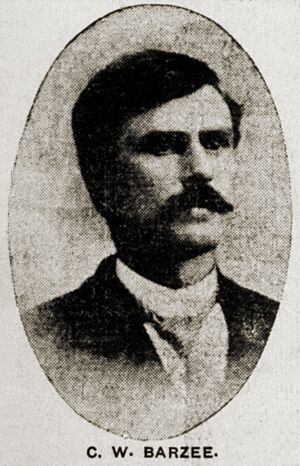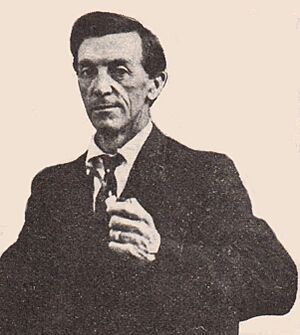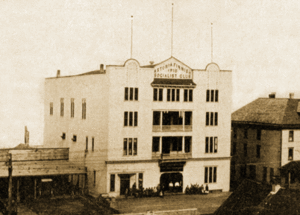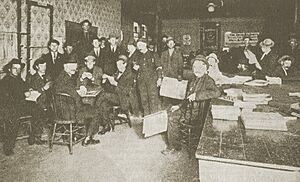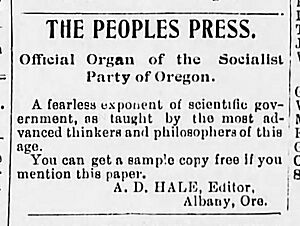Socialist Party of Oregon facts for kids
Quick facts for kids
Socialist Party of Oregon
|
|
|---|---|
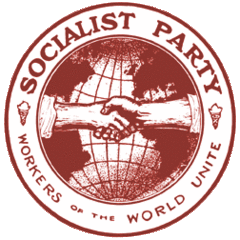 |
|
| Founded | 1899 (SDP) 1901 (SPA) 1992 (SPUSA) |
| Ideology | Socialism Socialist feminism |
| Political position | Left-wing |
| Colors | Red |
The Socialist Party of Oregon (SPO) was a political group in Oregon, USA. It actually refers to three different but related organizations over time. First, it was a branch of the Social Democratic Party of America (which later became the Socialist Party of America) from the late 1890s until the 1950s. Later, it was also the Oregon branch of the Socialist Party USA from 1992 to 1999.
Contents
- The Early Socialist Party in Oregon (1890s–1950s)
- Party Meetings and Conventions
- Leaders of the Socialist Party of Oregon
- Socialist Party of Oregon Membership Numbers
- Reorganization in 1992
- Important Oregon Socialists
- Oregon Socialist Newspapers and Publications
- See also
The Early Socialist Party in Oregon (1890s–1950s)
How the Party Started
The Socialist Party of Oregon began in the late 1890s. At that time, local groups of the Social Democratic Party of America (SDP) started forming. The first news about an SDP group in Oregon appeared in a newspaper in October 1899. By the end of that year, a basic state organization was set up. J.D. Stevens of Portland was the state organizer, working to create more local groups.
The SDP slowly grew in 1900. A local group started in Oregon City in March. Then, a formal meeting was held in Portland on April 10, 1900. In the 1900 election, the presidential candidates Eugene V. Debs and Job Harriman received about 1.76% of the votes in Oregon. They ran together for the two SDP groups.
After the Socialist Party of America was officially formed in August 1901, efforts began to organize Oregon under this new party name. The first meeting for this was on September 25, 1901, in Salem. Only about a dozen people attended. They chose leaders and decided that Albany would be the first headquarters. Oregon received its official state charter from the national party in October 1901. Some counties also started organizing, like Clackamas County, where 50 people formed a local group.
The party grew quickly in 1902, especially in different counties. For example, over 100 people met in Marion County on March 5, 1902, to choose candidates and agree on their goals. The new SPO was able to put many candidates on the ballot for the June 1902 election. R.R. Ryan ran for Governor, and C. W. Barzee ran for Secretary of State.
In March 1904, the party decided to move its headquarters to Portland. It stayed there for many years. In the 1904 election, the Socialist Party's candidates, Debs and Benjamin Hanford, received about 8.5% of the votes.
Oregon Socialists Compared to Washington
Oregon was an older state than its neighbor, Washington. However, the Socialist Party in Oregon never became as large or powerful as the Socialist Party of Washington. Oregon also didn't produce any newspapers that were read across the country, unlike some in Washington.
Portland, Oregon's largest city, was seen as more orderly than Seattle. Historian Carlos A. Schwantes noted that Portland was "conservative" and focused on business. Because of this, the labor movement in Oregon was more careful than the workers in Washington's Puget Sound area.
The "Red Special" Train in 1908
The 1908 election brought presidential candidate Eugene Debs to Oregon. He traveled on a special train called the "Red Special." This train was rented by the Socialist Party and stopped at many towns across the country for campaign speeches. The train made several stops in Oregon on September 14, which really excited the party members.
In Eugene, Debs told the crowd, "I am the candidate of the workingmen, and don't expect the votes of any capitalists." In Albany, he said that the two main political parties represented rich business owners, not the people. He also said that the Republican Party had finished its job by freeing slaves and had since become a party for the very wealthy.
That evening, Debs gave a speech in Portland that attracted over 10,000 people. The crowd was so excited when he appeared that they cheered and shouted loudly.
Tom Sladden, the SPO State Secretary, was very optimistic. He noted that 3,000 people marched in Portland before Debs' speech. Sladden believed the party would get more votes in November. He also pointed out that from 1904 to 1908, the number of Socialist Party local groups in Oregon grew from 32 to 74, even without many full-time organizers.
The Strongest Years of Oregon Socialism
The years 1910 to 1912 were a peak time for the Socialist Party of Oregon. On May Day 1910, the party held a big parade in Portland. About 1,500 members and supporters, wearing red ribbons and carrying red banners, marched through the streets. They marched without police help or interference to a vacant lot. There, a crowd of about 4,000 people listened to speeches and sang songs like "The Red Flag." Afterward, they went to the Finnish Socialist Hall for more singing and dancing.
In June 1910, Klamath Falls became the site of the first "Socialist Encampment" in the Western United States, called "Camp Progress." This idea was borrowed from religious "revival meetings." Socialists and their friends camped together in over 60 tents. In the evenings, they held political meetings where they sang, watched plays, listened to speakers and debates, and enjoyed music from a 12-member band. Local community members were invited, and between 2,000 and 3,000 people attended each evening during the 8-day encampment.
One Oregon Socialist who attended felt the 1910 Encampment was a big step forward for the party. They noted the strong feeling of friendship and equality among everyone there.
The Socialist Party also did well in the November 1910 election. W.S. Richards, a furniture factory worker, received over 7.5% of the total votes in his campaign for Governor of Oregon.
By the summer of 1915, the SPO had English-speaking local groups in 69 towns in Oregon. There were also Finnish-speaking groups in Astoria and Svenson, plus Finnish, Latvian, German, and Polish groups in Portland.
The Finnish Socialists of Astoria
The early Socialist Party of Oregon was like two groups working together. One was English-speaking and based in Portland. The other was Finnish-speaking, made up of people who had moved from Finland and settled in Astoria.
Many Finns came to North America starting in the 1860s, often to work in mines. Others came to escape political problems in Finland, which was then part of the Russian Empire. By the time of World War I, over 300,000 Finns had left their home country for jobs or freedom.
While not all Finnish immigrants were socialists, the idea of socialism was well-known in Finland. In the 1907 Finnish election, the Social Democratic Party of Finland won a large share of the votes. Many Finnish socialist leaders later had to leave Finland due to the Russian government. These ideas and leaders influenced the Finnish immigrant communities in America.
Astoria, Oregon, a fishing town of about 10,000 people, attracted many Finnish immigrants. It was somewhat isolated, making it easy for new Finns to find others who spoke their language.
Many Finns in Astoria worked as independent fishermen. Their work often required cooperation and teamwork. This meant their political views tended to be more moderate and focused on elections, rather than on ideas of big class struggles or revolution.
The Astoria Finnish Socialist Club (ASSK) started in 1904. It was a branch of the Finnish Socialist Federation (SSJ), which officially joined the Socialist Party of America in 1907. This club gave Finnish socialists a place to meet and connect with other Finnish speakers. Membership was open to Finns aged 18 or older who agreed with basic socialist ideas and paid small fees.
The ASSK started small with 27 members in 1904 and grew to 59 by 1909. It then grew quickly, reaching 250 members in 1911, which was almost 18% of the Socialist Party of Oregon's total members. After a small split, it still had 210 members in 1916. The club then saw another big increase in members, possibly due to excitement about revolutionary events in Russia and Finland. Its membership peaked at over 400 in the summer of 1918.
Finnish Socialist Newspapers
Finnish-American socialists had several newspapers in the early 1900s. One was Amerikan Suomalainen Työmies ("American Finnish Worker"), which started in 1903. Another was Raivaaja ("The Pioneer"), launched in 1905. The Finnish Socialist Federation decided to divide into three districts, and the Astoria Finns wanted their own newspaper for the Western District.
In June 1907, Finnish Socialist groups in the West voted to start a newspaper. A temporary board was set up in Astoria. They raised money by selling shares. The first issue of the new paper, called Toveri ("The Comrade"), came out on December 7, 1907. It was edited by Aku Rissanen. Although it was planned to come out twice a week, it appeared irregularly at first due to economic problems. It became a daily newspaper in 1912.
The newspaper Toveri attracted Santeri Nuorteva to Astoria in 1911. He became the paper's editor-in-chief for two years. Nuorteva was a very important figure in the Finnish-American socialist movement.
In 1911, the Western District of the SSJ encouraged its local groups to form special women's committees and branches. This was to increase the number of women in the socialist movement, especially as women were gaining the right to vote in the West. In Astoria, this led to a sewing club for social and fundraising purposes. They also started a special weekly newspaper for socialist women, Toveritar ("The Woman Comrade"). Toveritar began in July 1911 and continued until 1930. Besides socialist news, it included household tips, a section for youth, poetry, and stories.
So, while Oregon's Socialist movement didn't have a famous English newspaper, Toveri was important for the Western District of the SSJ, and Toveritar was the only Finnish-language newspaper for socialist women in the entire country. The Finnish Socialists of Astoria believed that having these two long-running newspapers and their role in educating workers were among their greatest achievements.
By 1923, besides its large Astoria branch, the Finnish Socialist Federation had three other branches in Oregon: one in Svensen (a logging area), one in Marshfield (now Coos Bay), and an urban branch in Portland.
Electoral Activities
The Finnish Socialists of Astoria wanted to take part in politics and win local government positions to advance their socialist goals. It took time for them to build their organization and confidence. In the 1904 election, the English-speaking Socialists of Clatsop County nominated many candidates, but no Finns were on the list.
The Finnish Socialists didn't run any candidates until the 1910 election. Then, they provided two candidates for State Representative and nominees for County Commissioner and County Treasurer. The English-speaking branch in Astoria nominated candidates for State Senator, Sheriff, and other county positions. Later that year, both groups worked together to put forward a full list of candidates for Astoria's city election. None of them won.
The elections of 1912 and 1914 followed a similar pattern. Full Socialist lists of candidates were put forward, with English speakers at the top, and both English and Finnish branches contributing candidates for other positions.
By 1916, the English branch seemed to have disappeared, leaving the Finnish members to fill the entire Socialist candidate list. Even so, the Astoria local group nominated a native American for Mayor of Astoria, while Finns filled 5 of the other 6 spots. They won one race.
In the 1918 election, when the Astoria Finnish Socialist Club had its highest membership, no candidates were nominated. This might have been because of strong anti-war feelings that discouraged English speakers, while Finnish speakers were focused on revolutionary events in their home country and Soviet Russia. From 1904 to 1916, Socialist candidates in Astoria usually received just over 10% of the votes, peaking at 15.2% in 1912.
Criminal Syndicalism Law
On January 14, 1919, a new law called the criminal syndicalism statute was introduced. This law made it a serious crime (felony) to speak or write about using "crime, sabotage, violence or any other unlawful methods of terrorism" to achieve political change.
Anyone who edited, printed, or shared a newspaper or pamphlet supporting such ideas, or helped form an organization that did, could be punished. The law called for up to 10 years in prison and fines of up to $5,000. The authorities quickly used this new law. Less than a week after it took effect, Harlin Talbert, the State Secretary of the Socialist Party of Oregon, and five others were arrested for selling copies of The Western Socialist and for "distributing handbills without a license."
End of Finnish Participation in the SPO
In the summer of 1919, the Socialist Party of America (SPA) split into three parts. The main group suspended six large language groups, including some Finnish ones, because they supported a "Left Wing Manifesto" that called for more revolutionary changes. While the Finnish Socialist Federation didn't officially support this manifesto, many of its members felt sympathetic to the revolutionary ideas and were unhappy with the main party's actions.
At its national meeting in Waukegan, Illinois, from December 1920 to January 1921, the Finnish Socialist Federation decided to leave the SPA and become an independent organization. Toveri, under editor Elis Sulkanen, strongly supported this decision.
When the Socialist Party's Executive Secretary, Otto Branstetter, learned of this, he immediately started to create a new Finnish Federation that would stay with the Socialist Party. Many moderate members from the Eastern District of the now independent SSJ joined this new group, bringing their daily newspaper, Raivaaja, with them.
However, the Astoria Finns, like most of the Western District of the Finnish Federation, remained loyal to the independent organization. They stayed outside the Socialist Party, and their newspapers, Toveri and Toveritar, also remained independent. No new branches of the SPA's reorganized Finnish Federation were started in Oregon.
The Socialist Party of Oregon in the 1930s
The party continued to put candidates forward for public office throughout the early 1900s.
In 1934, the SPO, led by Albert Streiff and George Buickerood, left the Socialist Party of America. They claimed the SPA was "too radical." However, this separation didn't last long. Streiff and Buickerood later supported William Lemke in the 1936 Presidential election. After Don Sweetland became State Secretary and Monroe Sweetland became State Chairman at the 1936 State Convention, the SPO rejoined the national Socialist Party of America.
The party lost the ability to have candidates listed as "Socialist Party" candidates in the 1940s. Norman Thomas ran for president as an 'independent' or 'Independent Socialist Principles' candidate during this time. The party didn't have official Socialist candidates again for almost 50 years. It basically stopped existing as a group that could elect people in the mid-20th century.
Party Meetings and Conventions
The Social Democratic Party of Oregon held its first state meeting on July 12, 1900, in Portland. The goal was to choose people to vote for president in the November election. Each local group could send one person or have someone vote for them. This meeting also chose a State Executive Committee.
Before the July 1901 meeting that created the Socialist Party of America, a "socialist mass meeting" was held in Albany on May 31, 1901. This meeting called for a formal convention in Oregon by October 1 of that year. So, a meeting was called for September 21, 1901, in Salem to form a permanent state organization and create a formal plan. The Founding Convention, attended by about a dozen socialists, actually took place on Sunday, September 25, at that location.
The 1902 State Convention was held on March 19, 1902, in Portland. About 175 to 200 Socialists attended. They nominated R.R. Ryan for Governor and other candidates. The party's plan included a rule to exclude Chinese and Japanese immigrants from the United States.
A special 1903 Nominating Convention was held on April 3, 1903, in Salem. About 50 people attended. They chose John W. Ingle, a farmer from Corvallis, as their candidate for a special election. A new plan was approved, which talked about the basic idea of the class struggle and said that the ballot was the only way for the working class to fight the capitalist system.
The 1904 State Convention was held on March 3 in Portland. This meeting adopted a new set of rules for the SPO. Portland was chosen as the new state headquarters. The party promised to "conduct all the affairs of the state in such a manner as to promote the interests of the working class."
The 1906 State Convention was held in March 1906. It chose farmer C.W. Barzee as the candidate for governor. Local county meetings were held throughout March, nominating many candidates for local offices.
The 1910 State Convention was held on August 7, 1910, in Portland. The party's candidates for the November 1910 election included W.S. Richards for Governor. They also approved a plan that called for all citizens over 21 to be able to vote, "regardless of sex, color, or property qualifications." It also called for changing the ownership of production means from private to collective.
1940 Picnic – As World War II was approaching, the smaller Socialist Party of Oregon remained against the war. They hosted a picnic for Oregon progressives on August 18, 1940, near West Salem, Oregon. This gathering was meant to bring together "farmers, union members, anti-war people, members of co-ops, pacifists, socialists, and progressives" to work together against military drafts and limits on civil liberties.
Leaders of the Socialist Party of Oregon
- W. S. Richards, Albany. (1901–1904)
- A.H. Axelson, Portland. (1904–1905)
- Claude Robinson, Portland. (1905)
- Thomas A. Sladden, Portland. (1905–1908)
- C. W. Barzee, The Dalles (1909-1910+)
Socialist Party of Oregon Membership Numbers
| Year | Average Paid Membership | Exempt Members | National SPA Membership |
|---|---|---|---|
| 1901 | n/a | 4,759 paid (of 7,629) | |
| 1902 | 172 | n/a | 9,949 |
| 1903 | n/a | 15,975 | |
| 1904 | 482 | n/a | 20,763 |
| 1905 | 435 | n/a | 23,327 |
| 1906 | 516 | n/a | 26,784 |
| 1907 | 698 | n/a | 29,270 |
| 1908 | 924 | n/a | 41,751 |
| 1909 | 855 | n/a | 41,470 |
| 1910 | 1,212 | n/a | 58,011 |
| 1911 | 1,429 | n/a | 84,716 |
| 1912 | 2,205 | n/a | 118,045 |
| 1913 | 1,600 | 95,957 | |
| 1914 | 1,281 | 93,579 | |
| 1915 | 967 | 79,374 | |
| 1916 | 1,215 | 83,284 | |
| 1917 | 827 | 80,379 | |
| 1918 | 1,363 (first 6 mos.) | 82,344 | |
| 1919 | 104,822 | ||
| 1920 | 26,766 | ||
| 1921 | 13,484 | ||
| 1922 | 11,019 | ||
| 1923 | 10,662 | ||
| 1924 | 10,125 | ||
| 1925 | 8,558 | ||
| 1926 | 8,392 | ||
| 1927 | 7,425 | ||
| 1928 | 7,793 | ||
| 1929 | 9,560 | ||
| 1930 | 9,736 | ||
| 1931 | 10,389 | ||
| 1932 | 16,863 | ||
| 1933 | 18,548 | ||
| 1934 | 20,951 | ||
| 1935 | 19,121 | ||
| 1936 | 11,922 |
Reorganization in 1992
|
Socialist Party of Oregon
|
|
|---|---|
| Chairperson | Michael C. Marino |
| Founded | 1992 |
| Headquarters | Portland, Oregon |
| Ideology | Democratic socialism |
| National affiliation | Independent (formerly: SPUSA) |
| Colors | Red and black |
The Socialist Party of Oregon was started again in 1992 by members of the Socialist Party USA. These members included Walt Brown, who later ran for president in 2004, Bill Smaldone, James Hadley, and Trey Smith. The new Socialist Party of Oregon was known for both its activism and for running candidates in elections. The party supported the "Health Care for All-Oregon" plan, helped workers unionize at Powell's bookstore, and was involved in the peace movement. It also served as the group for democratic socialist politics in Oregon.
The party gained the ability to put candidates on the ballot by taking over the ballot lines of other small parties. For example, they acquired the No Sales Tax Party around 1994 and changed its name to the Socialist Party. They also acquired the Representative Party that same year and changed its name. In 1995, they acquired the ballot line of the New Alliance Party, which gave the Socialist Party of Oregon "minor party" status across the state. The Socialist Party regularly ran candidates for office after that. However, in 1998, the party didn't get enough votes (1% statewide) and lost its statewide ballot access.
By November 2008, the party was recognized by the Oregon State Elections Division as a "less than statewide" nominating party. This meant they could only nominate candidates in certain areas, not across the whole state. Party organizers then planned to get ballot access in other areas by collecting signatures in individual state house districts.
Some parts of the party's ballot access remained active until 2008. That same year, the organization separated from the national Socialist Party USA. It now continues as a small, independent political group.
The party has had a few recent successes in elections, though it has not won a partisan elected office since it reorganized:
- Bill Smaldone was elected to the Salem City Council in 1998.
- Michael C. Marino was elected to the Northwest District Association from 1999 to 2008.
Important Oregon Socialists
- Henry Askeli
- C. W. Barzee
- Walt Brown
- Tom Burns
- Louise Bryant
- William Z. Foster
- T. E. Latimer
- Tom J. Lewis
- Santeri Nuorteva
- Wally Priestly
- Benjamin F. Ramp
- Floyd C. Ramp
- John Reed
- William N. Reivo
- W. S. Richards
- Thomas A. Sladden
- Bill Smaldone
- Albert Streiff
- Monroe Sweetland
- Elis Sulkanen
- Trey Smith
- Harlin Talbert
- John Viita
- Harry M. Wicks
Oregon Socialist Newspapers and Publications
Albany
- The People's Press (1894–1901) — Became socialist in 1899; was the official newspaper of the SPO in 1901.
- Discontent (1913?)
Astoria
- Toveri [The Comrade] (1907–1931) — The newspaper of the Finnish Socialist Federation.
- Toveritar [The Woman Comrade] (1911–1930) — Also from the Finnish Socialist Federation.
Grants Pass
- The Real Issue (1904–1905) — Official newspaper of the SPO.
Medford
- Saturday Review (1913)
Milwaukie
- The Alliance (1912–1915)
Portland
- Pacific Coast Citizen (1901–?)
- Vapauttaja (The Liberator) (1902–1903) — An early Finnish socialist paper.
- The Liberator (1903)
- Worker's Voice (1910)
- Oregon Socialist Party Bulletin (1910–1919) — Official newspaper of the SPO.
- The Hourglass (1915)
- Oregon Herald (1916–1917)
- Western Socialist (1919)
- Till Kamp (Into Battle) (1919) — A bulletin from a Scandinavian Socialist group.
- Oregon Socialist Party News (1945–1947)
- Portland Socialist (2003–2007)
- Portland Current (2007-present)
- The Oregon Socialist (1995, 1999, 2005–2008)
Salem
- Oregon Socialist Searchlight (1950–1952) — Official newspaper of the SPO.
- Expansive Democracy (1995) — Official newspaper of the SPO.
See also
- Socialist Party of Missouri
- Socialist Party of North Dakota
- Socialist Party of Oklahoma
- Socialist Party of Washington
- Social-Democratic Party of Wisconsin
- Finnish Socialist Federation
- Western Workmen's Co-operative Publishing Company


